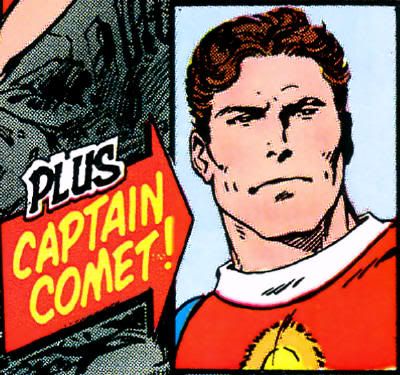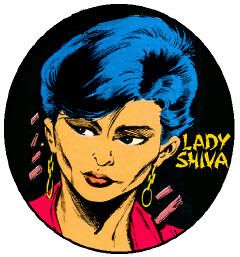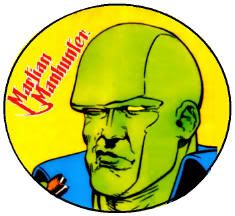
Golden Age comics weren't nearly as sanitary as most folks seem to think, but writer/historians like Roy Thomas managed to regurgitate their tales through the filter of bland Silver Age Comics Code Approved drivel throughout the 70s and 80s, spoiling these greats for a generation or two.
While DC celebrated its 50th anniversary with character deaths and revision/deconstruction, sometimes documented in the front of Secret Origins, the back was devoted to dry recitation of yellowed tales about characters dismissed as too inherently dated to rate an update. Instead of the most dynamic and lush artists of the Golden Age drawing these heroes, Secret Origins had bottom feeders whose clinical, impersonal styles had fallen out of favor at DC after twenty years as an anchor around the company's neck.
For instance, there's Captain Comet, appearing in a tale by Thomas and Ron Harris with poorly meshing inks by the usually swell Bruce D. Patterson. Following a revised Doom Patrol origin by Paul Kupperberg and John Byrne in his prime, Comet couldn't have been more off-putting and pedestrian.
The retelling opens in 1951, with a grim, more detailed description of the onslaught of the giant tops that were originally set-up at the end of Strange Adventures #9: "The Origin of Captain Comet!" (June 1951). Captain Comet then made a more visually dramatic debut, crashing through a police barricade at super speed. At a sprawling Midwestern university, Professor Emery Zackro heard the news on the radio, and launched into a fairly faithful flashback to Comet's first story (which had been told in chronological order, not the hopscotch of this telling.) Now, the first version was drawn by Carmine Infantino, and though not as expressive as he would be in later years on The Flash or Adam Strange in Mystery In Space, was still a beaut'. Harris' take could only have been more bland if he didn't have Patterson's embellishment, and his mustache on Zackro is so long and straight it breaks panel borders. Running the same number of pages as Comet's two-part debut, this version still seems drawn out and slow moving. There's greater detail being imparted, but it proves unnecessary baggage. Also, the gangster's bullet bounces off Adam Blake's brow instead of his chest, all the better to fit it in long, skinny panels. Though quite faithful to the original's plot, the storytelling here lacks the bounce.
Another important distinction is that the seeming subtext of Broome's seminal story is dialed down to a barely audible hum. Look at Broome's opening captions and Blake's emotionally troubled reaction to his mutation separating him from all of humanity. However evolved Blake may be, he's clearly lost something essential to modern man that plagues him. Whether he was gay, had a micropenis or hid a skirt under his spacesuit is unknown to me, but at least by 1951 standards, there has got to be something "wrong" with Blake for him to whine to a Stan Lee degree. I lean toward closeted homosexuality, myself. For instance, Blake saves a hot blond from a dangerous fall with his telekinesis, and then proceeds to not score with the chick, who never appeared again. What red-blooded hetero would allow such a bird to escape? But no, Blake runs to Prof. Zackro, an apparently unmarried older fop with dandy Victorian facial hair. Zackro helped instill in Blake a fear of ever revealing his terrible "secret," and how the resultant media attention would ruin his life.
Combining a belt with suspenders wouldn't be the choice of a queer eye, but his asymmetrical winged buckle was to die for! That belt sure didn't get in the way of Blake's casually disrobing in front of Prof. Zackro, with whom he soon came to live. Yep, just two straight guys, living together, teacher and student, sharing a "secret" they mustn't share, and all with no women in sight. Sure. Move over Northstar, because the granddaddy of metaGLBT wants to finally out himself, right?

















3 comments:
Isn't it more likely his reaction to his mutation was supposed to echo the reaction adolescent boys had to their changing bodies? Where's all this hair come from? How come this thing gets hard whenever I think about girls (or other boys)? And since the readers were assumed to be at that awkward age when they began feeling an attraction to girls, but still felt more comfortable in the company of other boys (a stage many heterosexual males never outgrow), of course they were offered stories with an all-male environment. Comet's real problem was that he was a teenage boy in an adult body; that is, a typical super-hero.
But if you want him to be gay, that works for me. Your revisionist origin is more interesting than anything Roy Thomas could dream up. If not for the popularity JLI, "The Secret Origin of the Martian Manhunter" would have been one of Roy's dreary SECRET ORIGINS back-ups, with Joe Certa's panels redrawn by Rich Buckler and inked by an elderly Murphy Anderson.
I like teh gaye, and it goes with the intentional undercurrent in my posts here of spotlighting women and minorities of the DC Universe. However, in the last issue of R.E.B.E.L.S. I read, Comet was intent on leaving the team until Starfire showed up. Unless this is the hardly atypical homosexual fascination with large breasts and supporting platonic "girlfriends," my Log Cabin Rocketmen theory may be a bust.
As for you Roy Thomas comments-- inspiring! Now I kind of want to go through each Secret Origins tepid tailgunner and try to read entirely too much into it. "...this proves that Firebrand I died a virgin ...it can be inferred that the Human Bomb was addicted to opium ...which settles any dispute that Alan Scott voted for Herbert Hoover ...and that's how we know Red Bee was a Jehovah's Witness."
Maybe he's bi, or maybe he's -- what's the sci-fi comics equivalent of metrosexual? -- galaxisexual? cosmisexual? astrosexual?
Post a Comment